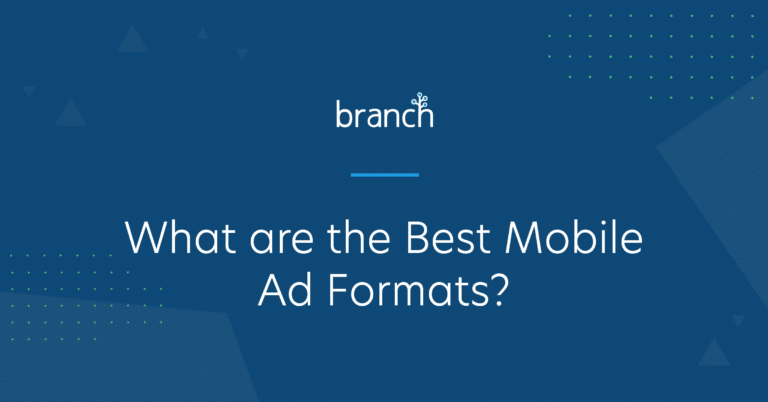More and more consumers are spending time on mobile devices instead of their desktops. In fact, 58% of all site visits occur on mobile, and that number is projected to keep growing. And with the number of smartphone users worldwide expected to grow to 3.8 billion by 2021, mobile marketers are presented with a unique opportunity to capitalize on this trend and drive app growth. However, choosing the right mobile ad formats to ensure campaigns have the largest reach and engagement possible can be tricky.
To help you choose which types of mobile ad formats to use in order to optimize your marketing spend and increase conversion rates for your app, we’ve pulled together tips and best practices for six key mobile ad formats.
What are the Different Types of Mobile Ad Formats?
Search Ads (Browser/App Store)
Search ads are one of the most effective ad formats for acquiring new customers and app users. This is largely because they reach users at the exact time they’re actively searching for a solution, which indicates high intent — and high likelihood they’ll convert.
Types of search ads:
Web Search Ads (Google, Bing, Baidu)
Web search ads show on a search engine results page and are triggered by keywords a user searches. They usually appear above or to the right of organic search results. The higher on the search results page you want your ad to be for a certain keyword, the more you pay.
App Store Search Ads (iOS App Store, Google Play Store)
Like web search ads, you can pay to have your app listed higher on the search results page of an app store when a user searches for certain keywords. Both Apple and Google enable search ads on their app stores; however, the process for setting up your search ads differs by platform. You can place ads in the iOS App Store via Apple Search Ads and in the Google Play Store via App Campaigns.
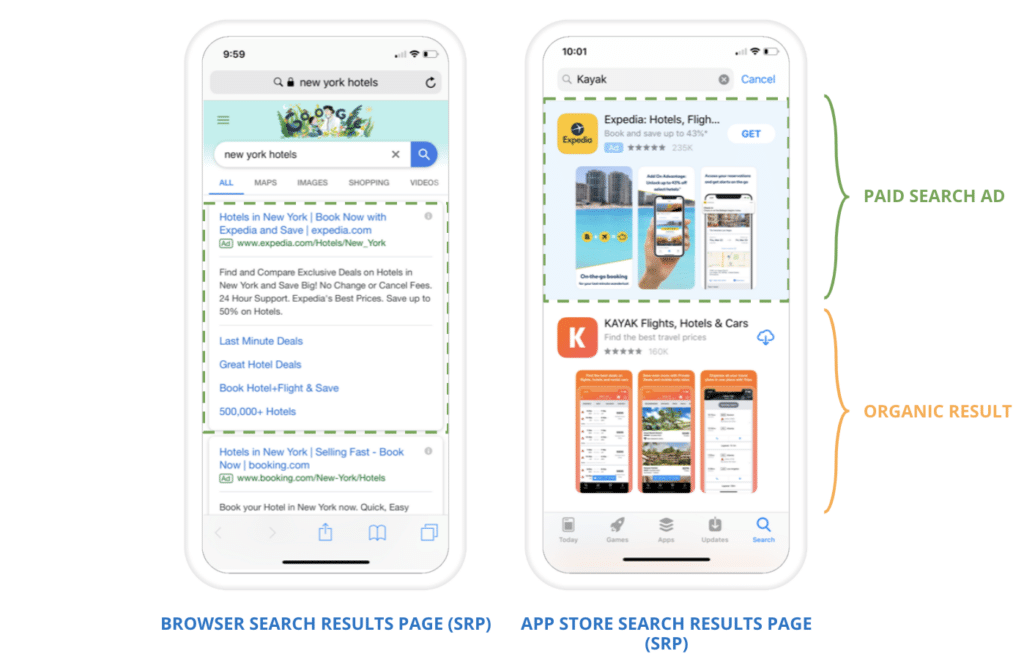
Benefits of search ads:
- High intent: Since users are searching in the app store, that indicates they’re ready to download an app. Make sure the keywords you bid on are directly related to your app to ensure you’re reaching the right people.
- Highly measurable: Search ads give you numerous insights into users who click your ads — from geographics, device types, and down-funnel conversion metrics like time/money spent on your website.
TIP: When building your app search ads, choose app screenshots that are aesthetically pleasing and make sure your app information is correct. Additionally, make sure you track your search ad campaigns closely to continuously optimize for performance and cost. And to compare the performance of your paid search ad campaigns against all of your mobile growth marketing activities, use a tool like Branch’s Universal Ads.
Display/Banner Ads
Display ads are “displayed” on a website to reach site visitors. They can include images, graphics, and text at varying sizes. Display ads are popular because they can be placed anywhere on a website, can catch the user’s attention through compelling creative, and stand out against a sea of text. A banner ad is a specific type of display ad that is 468×60 pixels in size, and appears at the top or bottom of a web page. Display ads and banners allow you to retarget people who have had prior exposure to your product or service, or advertise to target demographics like people who have expressed interest in products or services similar to yours.
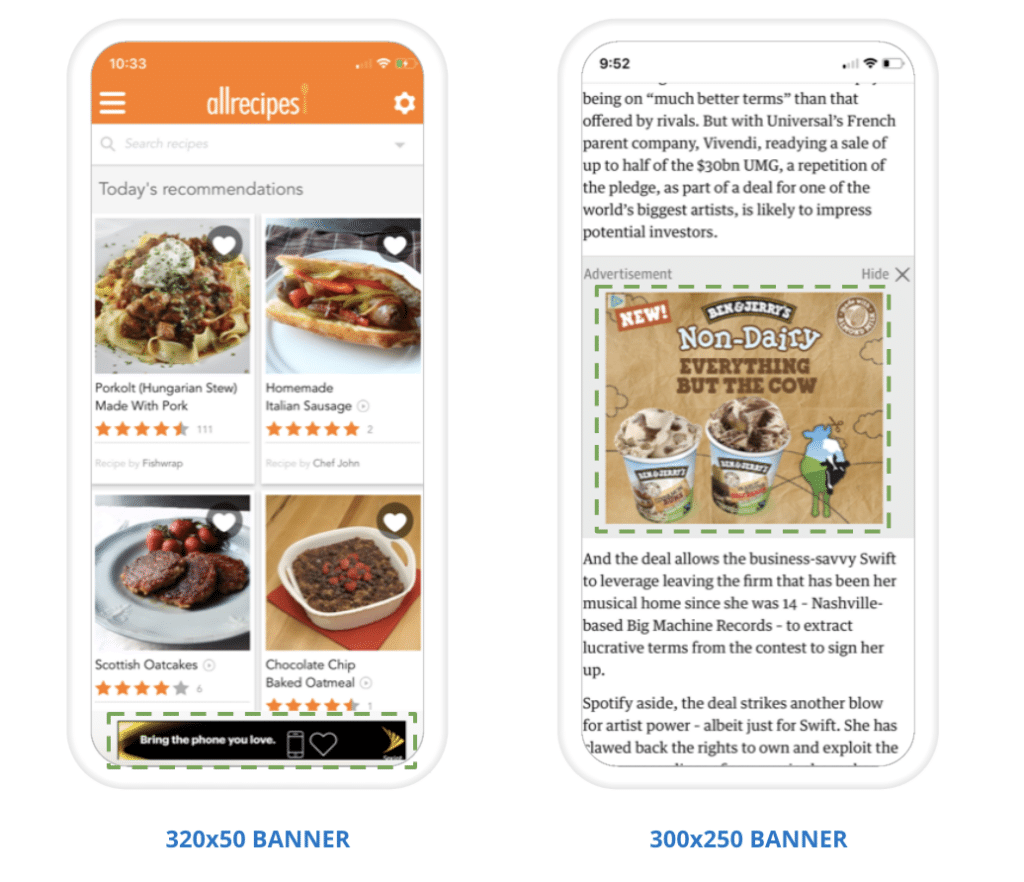
Benefits of display ads:
- Reach: Display ads are published through ad networks, so your ads will be displayed on a number of websites to maximize the reach and impressions.
- Flexible cost: Ad networks allow you to choose which metric to optimize your campaigns for (clicks, impressions, or installs), and you can bid as much or as little as you’d like to maximize those results.
TIP: Make sure when a user clicks on your display ad, they are brought directly to your app rather than the mobile web or an error page. With Branch’s Universal Ads, you can ensure your display ads deep link into your app while gaining a full picture of ad campaign performance against your other marketing activities.
Mobile Interstitials
A mobile interstitial uses a significant portion of the screen on a mobile website to inform and encourage users to open the native app, or install it if they don’t have it. According to Statista, mobile interstitials had an install-to-register rate of 27%. But make sure users are taken to the right place when they click your mobile interstitial.
Through deep linking, you can route users directly to your app from an interstitial — or to the app store to install. Traditional deep links take users to in-app content if they have the app previously installed while deferred deep links prompt new users to first download your app before being routed to the specific content in-app that was specified in your interstitial.
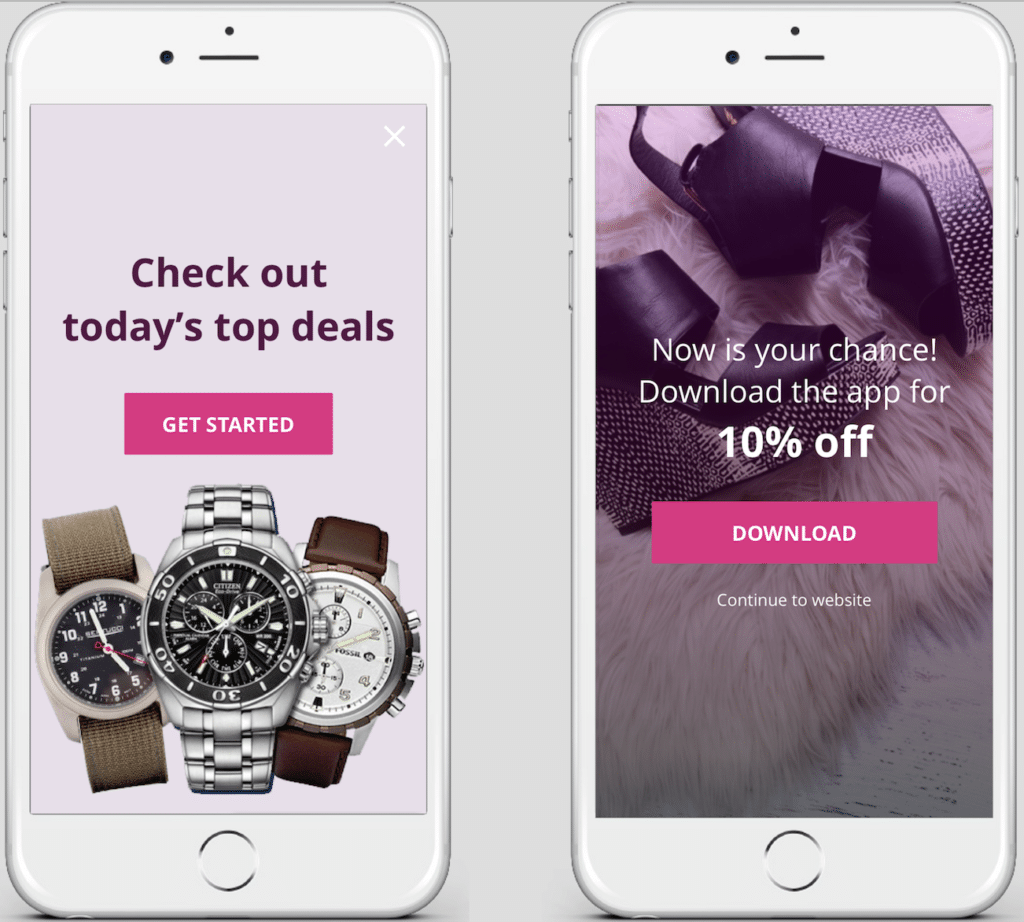
Benefits of mobile interstitials:
- They are larger than display ads: They can take up your whole screen, allowing for a more engaging experience.
- High install-to-purchase rate: 4.2% according to the 2019 In-App Engagement Report by Liftoff and Smaato.
TIP: While taking up more screen real estate is great for you, it’s essential that the ad does not disrupt the user’s experience on your website. Place the interstitial ad in natural transition points, such as when the user clicks on a product, after the user has scrolled to the bottom of a page, or as the user is navigating between functions — for example, as the user switches from viewing flights to hotels.
TIP: Create custom interstitials to drive your mobile web visitors to your app with Branch’s Journeys solution. Even better? With Journeys, you can personalize your interstitials based on user touchpoints to maximize the likelihood they’ll convert.
SMS Ads
SMS ads, or text message ads, are ads that are texted to customers’ cell phone numbers. Messages often have a shortened link pointing whatever the ad is promoting, or a prompt for the customer to reply to the ad with a code in order to access a special deal. Customers also have the option to opt out by sending a request for the messages to stop, so the pressure is on to make your SMS ads compelling.
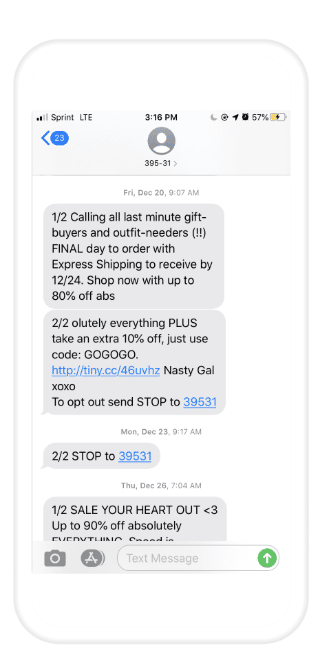
Examples of SMS ad campaigns:
- Messaging customers about discounts and special offers
- Running contests to win a prize or deal
- Sending a survey that the customer completes and is entered into a raffle
Benefits of SMS Ads:
- Almost guaranteed to be seen: 98% of SMS messages are opened.
- Personalized to the user: SMS ads can be customized to offer a personal touch.
- High-intent: Since the Telephone Consumer Protection Act requires user opt-in before companies can send SMS messages, this narrows the audience to users with high intent — increasing the likelihood that they’ll convert.
TIP: Make sure users are brought to the right place when they click on links in your SMS ads — like a specific product or sale page within your app — using deep links. 66% of mobile transactions occur within a native app, so make sure your ad-to-app experience is seamless.
Native Ads
Native Ads are ads that fit the flow, feel, and content of the platform in which they are placed. It doesn’t seem like an advertisement at first glance, making them “native” to the content surrounding it. For example, you are scrolling through Instagram when you see an ad for a sweater. The ad looks like an Instagram post that blends in with the rest of the posts around it — but includes a CTA to Shop, See More, etc.
It’s important to note, however, that native ads aren’t only social media ads. Another example of a native ad is a sponsored news article on your favorite news site that fits seamlessly with the other content that site publishes.
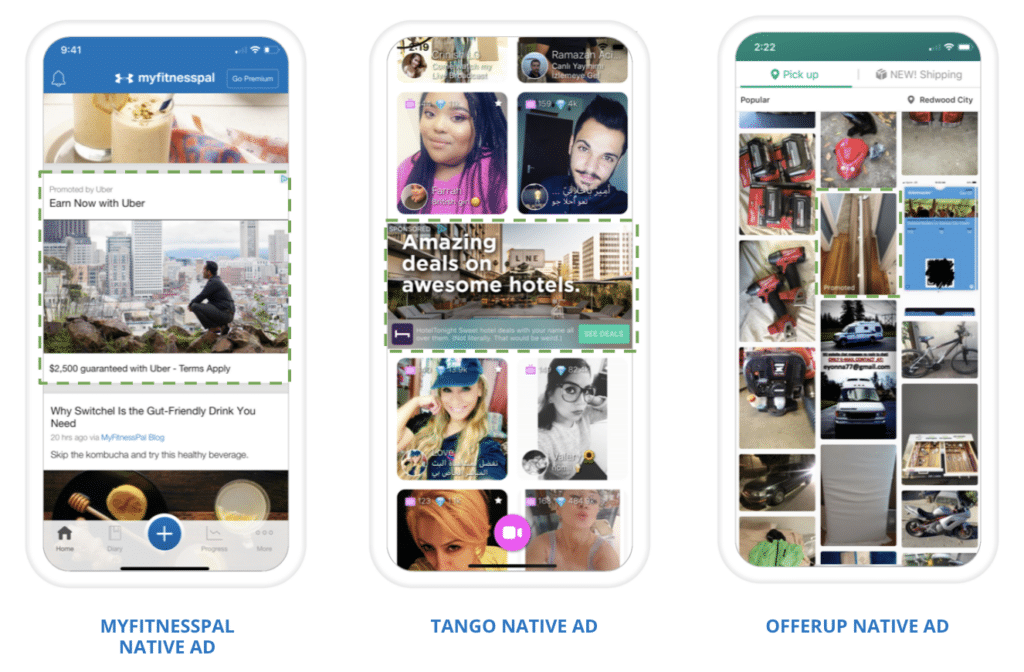
Benefits of Native Ads:
- Highly effective: Native in-app ads had the highest install-to-register rate at 36.5% according to Statista.
- Users don’t mind them: Because native ads flow with the content the user is already viewing, your audience doesn’t feel like they are being advertised to aggressively. However, note that you must disclose that the post is an ad per FTC regulations.
TIP: Make sure you have the right attribution partner to accurately measure your native ads’ performance. Branch’s Universal Ads solution tracks your ad conversions across channels to give you a full picture of the user journey, and unlocks more complete attribution data to better measure the performance of your ad campaigns.
Paid Social
As social media usage has risen over the past decade, so has the opportunity for advertisers to increase their reach on these platforms. Americans spend an average of 1 hour and 15 minutes on social media per day — a number that is expected to remain steady through at least 2021.
Paid social ads appear as sponsored posts within a social network feed. Each social media platform acts as an ad publisher, and has its own separate process to set up ads. Social media ads are typically native ads as they flow within the feed and are formatted to look like organic social media posts.
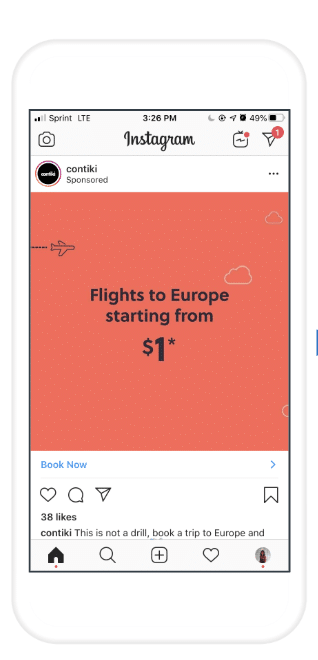
Some examples of paid social ads:
Facebook Ads allow you to set a campaign goal, select your audience, choose where to place your ad across Facebook’s network, as well as set your budget and ad format. Facebook Ads Manager also has some additional targeting features to help advertisers such as the option to create a lookalike audience, which targets users with similar characteristics as people who have already interacted with your business.
Twitter Ads also let you select your goal, audience, and budget. Twitter makes it fast and easy to increase your reach by promoting a single tweet without setting up a formal campaign — which is useful if you’re new to ads or if your main goal is to increase brand awareness.
Instagram Ads offer the chance to tell a unique and visually compelling story with a variety of ad formats from sponsored photo, carousel, and video posts to branded Instagram Stories. Similar to Facebook and Twitter, Instagram lets you pick your goals, audience, and budget with a few clicks. You can pay to promote individual posts or create ad campaigns through Ads Manager.
Benefits of paid social ads:
- Advanced targeting: Major social media giants like Facebook, Twitter, and Instagram let you select target demographics as you set up your campaign, allowing you to easily reach your intended audience.
- Greater visibility: With more users accessing social media through their phones than ever before, paid social ads offer larger reach and higher impressions, translating to increased conversions and brand awareness.
TIP: Social ads are a great place to test bold, edgy creative. Social media is not a great place to lead with product, list features, etc.
We know that building a successful mobile ad campaign to increase your app user base can be daunting. But no matter which ad formats you choose, make sure you have a mobile linking and measurement partner like Branch to create seamless ad-to-app experiences and give you full visibility into the performance of all of your campaigns across channels.
Ready to get started? Learn more about Branch’s Universal Ads or contact our sales team to discuss how Branch can help you drive mobile growth.






















